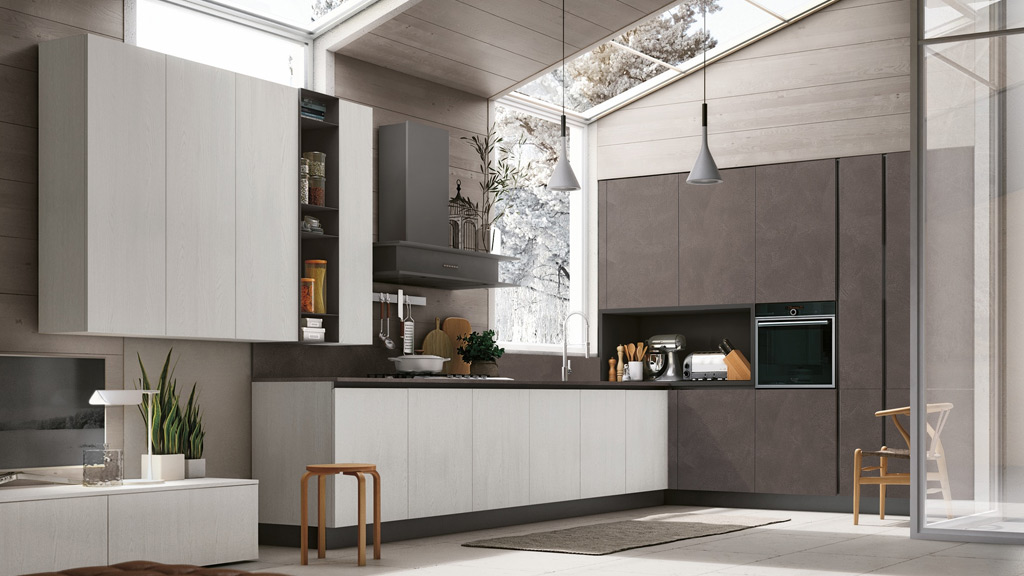” Your freshly assembled kitchen will not stay new forever.
In fact, the kitchen, together with the bathroom, is the room in the house that tends to get dirty more because it is precisely here that every person, family or group tends to spend the most time.
For this reason the kitchen is the environment of the house that requires more attention and care for cleaning and its maintenance.
The time dedicated to a few simple operations will pay off over the years, safeguarding your kitchen and keeping it beautiful and functional over time.
How to take care of it then?
First of all, here are some practical tips for general use and maintenance of the kitchen:
- Environmental conditions: the kitchen is mainly made up of parts in wood or derivatives. Temperature and humidity outside the established limits can damage the various elements;
- Distribute the load evenly: avoid concentration of weights, distribute heavier objects inside the cabinet bases;
- Do not overload with excessive weights: do not sit on the tops or tables, do not place ladders or work tools, do not climb on the tops to reach elements positioned at the top. Respect the maximum usable load requirements;
- Do not clean with abrasive tools: abrasive tools can scratch the kitchen, prefer the use of abrasive sponges microfibre cloths;
- Do not use acids, strong bases or solvents: observe the instructions for use where the use of certain acids, strong bases or solvents is absolutely forbidden. In general, remove immediately if they accidentally fall on items;
- Do not subject to contact with hot surfaces: very hot or hot objects can ruin the tops and / or alter their color. Avoid placing very hot or hot elements on the worktops and prefer the use of trivets;
- Avoid using steam cleaners: Steam cleaners emit high pressure steam. Steam can cause kitchen elements to swell.
- Avoid stagnation of liquids: water and stagnant liquids in general tend to dilate the wooden parts or / or the panels used. Remove liquids accidentally spilled on kitchen elements;
- Consult manufacturers’ instructions: it is important to read, observe and keep the instructions for use of the various manufacturers.

General Precautions
In general, the load must be evenly distributed on the surfaces in the kitchen, especially when referring to wall units and / or suspended base units. Always remember that obviously the load must be compatible with the wall used and with the installation of the installer. However, we advise you not to load the wall units and shelves with excessive weights and to distribute the heavier objects inside the base units and cabinets.
Humidity and temperature out of the norm can deform some parts of wood or kitchen derivatives: humidity can infiltrate the micropores and cause swelling. To avoid this it is necessary to keep the environment ventilated and dry as much as possible, with a rather stable temperature between 10 ° C and 35 ° C.
In general, if there are no specific indications, always use a microfibre cloth and a neutral soap for cleaning, avoiding creating stagnation of liquids.
When using double-sided adhesive tape, remember to always carefully clean the surfaces before gluing with isopropyl alcohol (no denatured alcohol) and a clean cotton cloth without releasing threads.
During the life of the kitchen, always pay attention that the refrigerator doors close perfectly and that the gaskets of the refrigerator itself are not worn. If, for any reason, you notice that the gasket on the fridge door does not close properly, it is likely that water vapor has come out of the fridge which can consequently damage the furniture, causing the sides to sag and the doors to swell. However, consider that small warps in the sides of the furniture can occur during the life of the kitchen, movements that do not compromise the aesthetics of the product if they are kept within 1.5 mm / m.
If there are built-in ovens and refrigerators or hobs, the kitchen must be equipped with ventilation grilles positioned in the plinth. For this reason, always check that they have not been removed and that there are no obstructions that limit or exclude the correct flow of air passage. Similarly, check that the ventilation areas in the upper parts of the columns are not obstructed.

